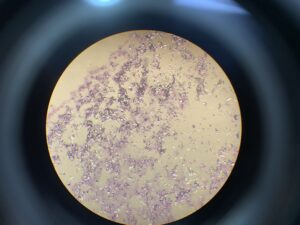Feline Lower Urinary Tract Disease, otherwise known as FLUTD, is a group of symptoms affecting the cat’s lower urinary system and bladder, which leads to difficulty and discomfort urinating, and in severe cases, can cause complete obstruction of the urinary tract. FLUTD is more serious in males than females as their urethra is more narrow, making them more likely to become blocked. This is an emergency situation and requires immediate veterinary attention. 
Most cases of FLUTD have the same symptoms, but there are numerous causes, including urolithiasis (stones in the urinary tract), cystitis (inflammation of the bladder) and urethral obstruction. FLUTD continues to be a heavily researched condition by veterinary bodies as there is still much that is unknown about the disease.
There are many causes for FLUTD some of which include; environment, genetics, diet, infections and stress. FLUTD can also occur in any breed and age, in neutered an entire animals, indoor and outdoor cats and those fed a variety of diets. It is one of the most serious and distressing cat diseases confronting cat owners and vets. If the obstruction is not relieved promptly, affected cats rapidly become very sick and may pass away.
Symptoms of FLUTD
- Irritability and restlessness
- Blood in the urine
- Frequent trips to the litter box and constant licking around the genitals
- Straining while in a squatting position (often mistaken for constipation)
- Urinating in unusual places about the house
If untreated or unnoticed, the condition may progress. With the kidneys unable to excrete urine, poisonous waste products build up. Cats with more advanced cases may emit deep cries of pain, strain constantly, have an enlarged, tender abdomen, or vomit and drool. They may also appear very quiet and unresponsive.
How is FLUTD treated?
- Clearing of a potential blockage – If the urinary passage is blocked, it is essential that a general anaesthetic be performed and the blockage be cleared. Although anaesthesia is dangerous due to the cat’s poor condition, there is unfortunately no alternative. At this point, some owners may choose not to go ahead with this procedure for multiple reasons and elect for humane euthanasia. Most of these blockages yield to flushing by catherisation (passing a fine tube) up the urethra. The catheter may be left in place for a few days and an elizabethan collar put on the cat to prevent them removing the catheter. The chances of success are generally directly proportional to how quickly the cat has been brought in for treatment by a veterinarian.
- Fluid Therapy – This is often necessary, but is always indicated if the cat is dehydrated or toxic. This consists of intravenous administration of large volumes of balanced fluids and is usually combined with a hospital stay, generally for 24-48 hours.
- Ongoing Medications – Most cats will receive antibiotics, pain relief and anti-spasmatic drugs to treat any infection and assist with ongoing urinary tract health.
Cats can unfortunately still pass away from this very serious condition even after extensive and timely treatment by a veterinarian. These deaths are usually associated with severe electrolyte imbalances, or where there is irreversible damage to the kidneys. Even more unfortunately, these conditions often recur, particularly where there is marked inflammation in the urinary tract or bladder. There are however medical and surgical methods that can help in the long term to prevent this awful disease. Specialised diets are often also recommended and required for a cat that has suffered from FLUTD, and these, along with changes around the home, can assist owners in making every possible effort to help prevent their cat suffering from FLUTD in the future.
If you suspect that your cat had FLUTD and is presenting with any concerning symptoms, please contact our hospital (03 9704 6463) or closest emergency centre immediately.
